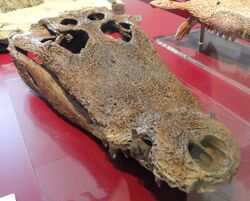Biology:Leidyosuchus
| Leidyosuchus | |
|---|---|

| |
| Leidyosuchus canadensis skull | |
| Scientific classification | |
| Domain: | Eukaryota |
| Kingdom: | Animalia |
| Phylum: | Chordata |
| Class: | Reptilia |
| Clade: | Archosauromorpha |
| Clade: | Archosauriformes |
| Order: | Crocodilia |
| Superfamily: | Alligatoroidea |
| Genus: | †Leidyosuchus Lambe, 1907 |
| Species | |
| |
Leidyosuchus (meaning "Leidy's crocodile") is an extinct genus of alligatoroid from the Late Cretaceous of Alberta. It was named in 1907 by Lawrence Lambe, and the type species is L. canadensis.[2] It is known from a number of specimens from the middle Campanian age Dinosaur Park Formation. It was a medium-sized alligatorid, with a maximum skull length greater than 40 centimeters (16 in).[3]
A number of species had been assigned to this genus over the years, including: L. acutidentatus (Sternberg, 1932), from the Paleocene of Saskatchewan; L. formidabilis (Erickson, 1976), from the Paleocene of North Dakota and Wyoming; L. gilmorei (Mook, 1942), from the Campanian of Alberta; L. multidentatus (Mook, 1930); L. riggsi (Schmidt, 1938); L. sternbergii (Gilmore, 1910), from the Maastrichtian (Late Cretaceous) of Colorado, Montana, North Dakota, South Dakota, and Wyoming; and L. wilsoni (Mook, 1959), from the Eocene of Wyoming.[3] However, in 1997 Chris Brochu reevaluated the genus and reassigned most of the species, transferring L. acutidentatus, L. formidabilis, L. sternbergii, and L. wilsoni to the new genus Borealosuchus, and L. multidentatus to the new genus Listrognathosuchus, proposing L. gilmorei as a synonym of L. canadensis, and finding L. riggsi to be too fragmentary to be determinable.[3][4]
Leidyosuchus is one of the basal-most members of the superfamily Alligatoroidea. Leidyosuchus's placement within Alligatoroidea can be shown in the cladogram below, based on a 2018 tip dating study by Lee & Yates that simultaneously used morphological, molecular (DNA sequencing), and stratigraphic (fossil age) data.[5]
| Crocodylia |
| ||||||||||||||||||||||||||||||||||||||||||||||||||||||||||||||||||||||||||||||||||||||||||||||||
References
- ↑ Rio, Jonathan P.; Mannion, Philip D. (6 September 2021). "Phylogenetic analysis of a new morphological dataset elucidates the evolutionary history of Crocodylia and resolves the long-standing gharial problem". PeerJ 9: e12094. doi:10.7717/peerj.12094. PMID 34567843.
- ↑ Lambe, Lawrence M. (1907). "On a new crocodilian genus and species from the Judith River Formation of Alberta". Transactions of the Royal Society of Canada. Series 3 1 (4): 219–235.
- ↑ 3.0 3.1 3.2 Wu, Xiao-Chun (2005). "Crocodylians". in Currie, Philip J.. Dinosaur Provincial Park: A Spectacular Ancient Ecosystem Revealed. Bloomington: Indiana University Press. pp. 277–291. ISBN 0-253-34595-2. https://archive.org/details/dinosaurprovinci0000unse/page/277.
- ↑ Brochu, C.A. (1997). "A review of "Leidyosuchus" (Crocodyliformes, Eusuchia) from the Cretaceous through Eocene of North America". Journal of Vertebrate Paleontology 17 (4): 679–697. doi:10.1080/02724634.1997.10011017.
- ↑ Michael S. Y. Lee; Adam M. Yates (27 June 2018). "Tip-dating and homoplasy: reconciling the shallow molecular divergences of modern gharials with their long fossil". Proceedings of the Royal Society B 285 (1881). doi:10.1098/rspb.2018.1071. PMID 30051855.
Wikidata ☰ Q2366128 entry
 |

